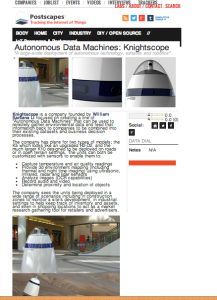I’m about to launch a new venture: paid speaking about the Internet of Things to corporate audiences and college students (details to come in the near future — but feel free to contact me NOW if you think of an audience that would be open to my evangelism for the IoT!).
One of the speeches I’m preparing is aimed squarely at college students — I’ve been excited to see how many 20 and 30-somethings play a lead role in the IoT and I’m also concerned about the future for these kids (my youngest very much included) in terms of the conventional economy — we’re in the process of leaving them with a very sorry mess, and I think they’re best advised to think outside-the-box and create their own opportunities.
WHICH IS A LONG WAY OF GETTING TO A GREAT CONVERSATION that I had at six AM today with one of those leaders who I plan to feature in the speech to provide inspiration, Alexandra Deschamps-Sonsino, who I knew primarily as the designer of the Good Night Lamp. I was quick to learn that she’s done much, much more, and was really there at the beginning of the IoT movement!
Here’s what I learned!

Alexandra Deschamps-Sonsino
She began studying product design in Montreal, and her professor told her to investigate the field of interactive design.
Wanting to go back to Europe, she enrolled in the program that many credit with being the home of the first maker movement in the IoT, as one of 17 students in the Design Institute of Ivrea, Italy. If that rings a distant bell, it’s because that’s where the Arduino board was developed, which has been the entry point for so many to the IoT. It was during this period that she actually designed the Good Night Lamp.

Good Night Lamps
She then moved to London, forming an Arduino distributorship with inventor Massimo Banzi.
She grew the business to about 12 people, which also did R & D on inter-connected products for companies such as BBC and Nokia.
Deschamps-Sonsino closed the business and then went back to consulting in 2010. In early 2013 she revisited the Good Night Lamp, getting it into production.
When I asked her whether her lack of a programming background was a handicap, she laughed, and said “I still don’t know how to program, but I know enough to be dangerous .. I have a really good understanding of what’s possible and what isn’t” in terms of programming. She thinks her awareness of programming is much higher than most product designers, who are ” … still interested in designing chairs and salt and pepper shakers!” She thinks that design education must evolve — too much of it is still focused on the kind of mid-20th century design that created cults around designers such as Philipp Starck. She is adamant that there is a role for product designers in the IoT, saying that most of the products have been designed by programmers, who come at product design from a technology perspective. In fact, she thinks that a lot of education will have to change because of the IoT, which she sees as a disruptive technology: “We have to get away from vertical learning niches, and put more emphasis on collaboration.” She shakes her head at one leading European manufacturer, where the product designers are physically isolated from the technologists and others, making collaboration impossible.
When I asked whether she’d faced any discrimination in the IoT world as a woman, Deschamps-Sonsino said:
“Not really, being a woman was actually useful because there aren’t many around: as long as it’s to my benefit, gets me in front of audiences, it’s OK. Some who got involved in the IoT in their 30s act inappropriately,but I’m managing it!”
Since I’m hoping to use these speeches to motivate young people to seek IoT careers, I concluded by asking her what the future holds:
“I think it has such tremendous potential, incredible opportunities. I think curiosity is the key. Start looking online for examples of IoT products: people keen to get feedback on their designs. Try to engage: take a 2-day workshop with Arduino. I’d particularly say to younger girls, the idea that tech for boys is total bullshit.
Young people have a lot to contribute. Opportunity for a lot of products because of the freshness of their outlook. You don’t have to learn to code. Other parts of the industry are ossified , but this is so open.” (my emphasis)
We wrapped up the conversation after 45 minutes. My day was already made! What an inspiration. Thanks, Alexandra!
 One is Postscapes, which I find to be an important all-around IoT news source. It features products (and links to their sites) in the “Body,” “Home,” “City” and “Industry” categories, as well as a DIY/Open Source grouping. The descriptions are well written and it’s attractive.
One is Postscapes, which I find to be an important all-around IoT news source. It features products (and links to their sites) in the “Body,” “Home,” “City” and “Industry” categories, as well as a DIY/Open Source grouping. The descriptions are well written and it’s attractive.


